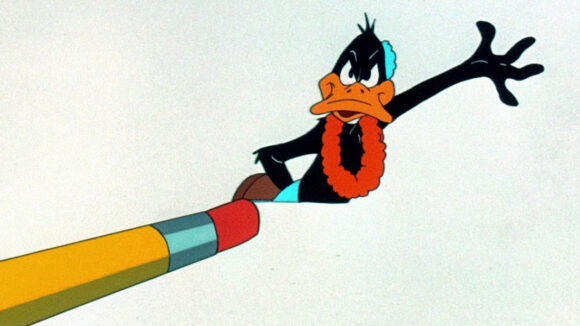

This Twitter Thread Delivers A Concise History Of Meta-Gags In Animation
In February, we spotlighted a smart Twitter thread about directors who transitioned from animation to live action. Now, the writer of that thread, Vincent Alexander, a cartoonist and animator from Columbus, Ohio, has outdone himself with another, even more entertaining thread.
This time around, Alexander gives a potted history of self-referential gags and tricks in cinema, both animation and live action. His subject is those moments in films and shows that riff on their own medium and business. The thread is worth reading in full, but we’ve picked out the animation highlights below.
Early on, Alexander introduces “meta” motifs developed in animation’s earliest days, such as the “hand of the artist” — the interaction between animator and animation, as seen here in the Fleischer brothers’ Koko the Clown cartoons.
Animated cartoons were making jokes about their own artificiality nearly from the beginning. Silent-era cartoon characters like Felix the Cat and Ko-Ko the Clown were constantly interacting with the animators drawing them and using floating punctuation marks as props. pic.twitter.com/Bf8RZmFJb8
— Vincent Alexander (@NonsenseIsland) October 2, 2020
He then demonstrates how later cartoons extended and subverted those tropes, rightly focusing on the mad inventiveness of Looney Tunes, Tex Avery, and Chuck Jones’s Duck Amuck.
Before Tex Avery headed for MGM, he left WB his greatest creation: a certain smart-alecky wabbit named Bugs Bunny. Having Bugs acknowledge that he’s in a cartoon, as he did frequently, didn’t diminish his character in the slightest. It only added to his likable self-awareness. pic.twitter.com/VgWUVY9tZc
— Vincent Alexander (@NonsenseIsland) October 2, 2020
Later in the century, as postmodernism reigned supreme and Who Framed Roger Rabbit spun a whole film out of animated meta-jokes, self-referentiality staged a comeback in American animation. Alexander chooses choice gags from era-defining shows like The Simpsons, Ren & Stimpy, and South Park.
Partially due to the success of 1988's WHO FRAMED ROGER RABBIT, zany cartoon humor made a comeback and fourth wall-breaking returned to TV cartoons with a vengeance. Here are some of my favorite examples: pic.twitter.com/69fYBKSarz
— Vincent Alexander (@NonsenseIsland) October 2, 2020
While the focus is on comedy, Alexander notes other ways in which the fourth wall can be broken. He shows us Jiminy Cricket address the audience at the start of Pinocchio, and reveals the influence of this narrative convention on subsequent live-action cinema.
The practice of having a narrator character address the movie audience goes back at least to Disney's PINOCCHIO, but it has been used throughout the years in films like FERRIS BUELLER'S DAY OFF, THE WOLF OF WALL STREET, and even this year's BIRDS OF PREY. Examples below: pic.twitter.com/VELJBtQxSr
— Vincent Alexander (@NonsenseIsland) October 2, 2020
Alexander rounds off the list with a delightful gag of his own:
To end this in the most self-serving way possible, I always enjoy breaking the fourth wall in my cartoons. I was once part of a screening where several of the files weren't playing right. When they screened my cartoon FIFTY SHADES OF GROUNDHOG, this gag got a big laugh: pic.twitter.com/ohg8o9Cj6y
— Vincent Alexander (@NonsenseIsland) October 2, 2020
The thread has fired our own imaginations. There are any number of animated meta-gags we could add to this list: Osamu Tezuka’s Broken Down Film, in which a cowboy contends with a bandit but also the crumminess of the film stock; the opening of Disney’s Aladdin (1992), when the camera rams into the merchant’s face; that wry Simpsons comment on limited animation. But for now, we’ll leave you with the glorious tribute to abstraction in art in Pixar’s Inside Out:
What are your favorite meta moments in animation? Let us know in a comment below.

